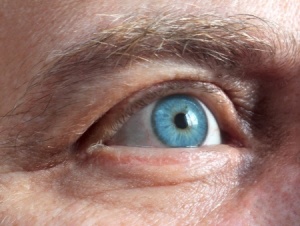See Your Way Clear
by Laura EdmistonPrevent eyesight loss from macular degeneration
Imagine driving your car down a busy street and suddenly realizing that your vision is clouded and gray, or you see spots everywhere you look. You can’t tell if the car in front of you is slowing down or if pedestrians in the crosswalk have made it to the other side. Suddenly your clear, crisp world is wavy or blurred and although you know it’s a blue-sky day, you feel as if you’re peering through fog. This is what it feels like to have age-related macular degeneration (AMD), a medical condition that results in loss of central vision due to damage to the retina, the light-sensitive layer of tissue at the back of the eye.
 Macular degeneration is serious. In fact, it is a major cause of blindness, and because the condition is painless, you may not realize you have it until damage has been done. Although loss of eyesight from this disease can be slowed or halted altogether, any damage before the condition is detected and treatment begins can be permanent. Fortunately, there are ways to keep your eyesight intact.
Macular degeneration is serious. In fact, it is a major cause of blindness, and because the condition is painless, you may not realize you have it until damage has been done. Although loss of eyesight from this disease can be slowed or halted altogether, any damage before the condition is detected and treatment begins can be permanent. Fortunately, there are ways to keep your eyesight intact.
Vitamins and Minerals
A good diet can go a long way toward preventing macular degeneration, so whether you prepare meals in your home or they are provided in a community setting, be sure foods high in lutein and zeaxanthin are part of the menu. These antioxidants are found in leafy vegetables, citrus fruits, tomatoes and melons, or can be taken as supplements. Also include plenty of broccoli, corn, spinach, peas and peaches to help ensure optimal eye health.
Vitamin D can also help to reduce the risk of AMD, particularly in women. Since vitamin D also strengthens bones and may reduce the chances of heart disease, you just can’t go wrong. Vitamin D is primarily available from sunlight, so get outside and roll up your sleeves to get a dose through your skin. Since it’s difficult to get enough vitamin D in winter, even in sunny Southern California, you may also want to take a supplement. Vitamin D is also found in fortified milk and orange juice, and green leafy vegetables.
Quit Smoking
If you’re a smoker you probably don’t want to hear this, but smoking is the single largest modifiable risk factor for developing AMD; it quadruples your risk. For some individuals, the risk is even higher (about 20 times average), due to genetic factors. Smoking cessation will reduce not only the risk of developing AMD, but progression of the disease if you already have it. The sooner you quit smoking the better off you will be, because the risk of AMD remains elevated for several years after quitting.
Blood Pressure and Exercise
Both hypertension and obesity—two conditions that can be alleviated by exercising—have been directly linked to the development of AMD, so get up and get moving. People who exercise have a 70 percent lower risk of developing MD than the general population. You don’t have to lift weights or run marathons, but moving your fingers to change the channel on the remote just won’t do it. Start by walking 10 minutes on most days and gradually work up to 20 or 30. It’s a healthy habit and you may be surprised at how much you enjoy it.
Get Regular Eye Exams
Regular eye exams won’t reduce your risk of AMD, but they can help you catch it early and treat it before it causes permanent damage. In addition to seeing an optometrist or ophthalmologist regularly, individuals at a high risk of developing AMD should regularly self-assess with an Amsler grid, a very simple screening test that can be downloaded from the Internet and easily used at home. Regular self-checks on an Amsler grid can lead to early detection and thus early intervention. It only takes a few seconds (really!) to use an Amsler grid, so you can make it a part of your bedtime or morning routine.
Protecting Vision
We all rely heavily on our eyesight, more than we know. Whether or not you drive a car, you still use your eyes to navigate your living space, direct your fork to your mouth, enjoy a beautiful walk on the streets of your neighborhood and see the faces of your loved ones, so the vision loss associated with this disease is devastating no matter who you are or where you may live.
The keys to healthy vision are good nutrition, exercise and regular eye exams. Isn’t it interesting that the same recommendations apply to almost every aspect of wellness?
